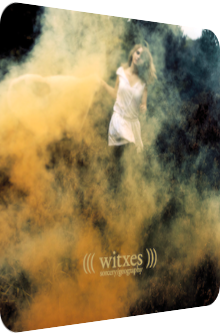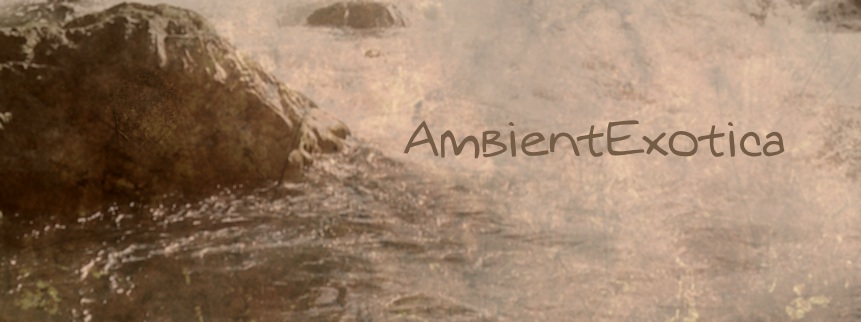
Witxes
Sorcery/Geography
2012
It remains astonishing to me as a reviewer, but especially so as a listener, that the Drone genre continues to be vivid, vivacious and more alive than ever. If there is one trend of 2012, it is the gradual increase of piano arrangements and the addition of other classic instruments which either bathe in synthscapes or are presented unplugged, with no processing whatsoever. The project of Lyon-based Maxime Vavasseur aka Witxes injects this dichotomy of classicism into his inscrutable-shadowy debut Sorcery/Geography, actually Witxes' second LP, but the first to be officially released, recorded between Autumn 2010 and Winter 2011 in various French locations, offered in both a digital edition and in vinyl form on Humanist Records in 2012, mastered by Lawrence English and given to me in digital form by Vavasseur himself for review purposes. Each of the ten tracks presents the feeling of being enchanted or entranced, but not by – excuse me – such mundane things as beautiful women or luring landscapes, but primarily by feelings, emotions and twilight-illuminated out-of-body experiences. Two particular characteristic traits of Witxes' productions come to mind: they are boldly cinematic and glaringly melancholic, with additional eerie or even brighter auras intertwined. The album's spell is channeled through the generous amount of patterns and surfaces, making the ensuing Dronescape heavy and thick. The listener, however, never has the feeling of being free or acting the way he or she desires. There is something uneasy and bewitching about the sounds. In order to lessen this impression a bit, Vavasseur got hold of many guest musicians who play classic drums, tenor saxophones or double bass, with Witxes himself playing the acoustic guitar and the piano. These glaringly jazzy instruments are thankfully real and unaltered; if they are processed, then only mildly so. The ensuing film noir-feeling is striking in those tunes where the saxophone is played. An electric guitar is also on board in order to fulfill the specific needs of the Dark Ambient crowd. Prepare for a gloomy, heavy-hearted, but never thrilling or shock-laden album.
Sorcery/Geography launches by stressing the first word of the album title: Unlocation has a mellow blur of magical mystique and demonic darkness all over it. Fading in slowly with wraithlike synth creeks, quavering cascades of lilac-colored soft noise patterns, ethereal Italo piano synth stabs and scattered classic piano tones, it is the double bass slaps by Christopher Honeyman which seem to be the only pristine, piercing element of this entrancing soundscape. Even Pierre-Loup Mollard's tenor saxophone and the staccato drums of Fabien Mysak seem to be somewhat silkened, softened and freed from their spikes and edges. Deep and powerfully dubby basslines accentuate the transcendental state of immersive encapsulation, the layers are magnanimously bolstered and texturized, the mood is similar to the entrancing enigma found in the songs of many Pop Ambient artists; Ulf Lohmann's Kristall and Triola's Dunkelraum come to mind. But Unlocation is far from over, as it comprises of a second, entirely different synth-less phase full of melancholic yet golden-shimmering acoustic guitar twangs. These instruments usually evoke a bonfire atmosphere, but not here, not after the lush opening section and due to the fact that the decay of each slapped string whirrs through the – now pitch-black – distance. Unlocation proves to be a fantastic, multifaceted opener, a gallimaufry of many surfaces and instruments. Up next is After The Horsefight, a terrifyingly crestfallen Dark Ambient composition with mechanically buzzing drone sounds, dragonfly-resembling vibrato tones deriving from a violin, and a glistening glacial synth melody of hopelessness. During all this time, tremendously threatening drones float in the background. Only the short polyphony of the lead violin provides sudden bursts of luminescence, but they are of a dusky red and inherit the same majestic hopelessness as the remaining layers. After The Horsefight shows Maxime Vavasseur's cinematic production scope for the first time, as all elements work together in tandem, boosting their respective traits and moods.
Thirteen Emeralds is a purposefully overdriven sawtooth Ambient piece that launches with a piano arrangement whose aorta is slowly underpinned by celestial synth strings, vinyl-like pops and liquedous sparkles. It is here where the acidic crunchiness of the electric guitar fades in, enhancing the mellifluousness with a decidedly more powerful layer. Despite its rustic rawness, many glittering constituents are omnipresent, even strengthened by fierce male chants which augment the lamenting aura of this piece, but also invoke a hidden purity that elevates and disassociates this tune from a customary electric guitar-based Drone piece. While Canyon Improbable launches with stereo-panned cybersaurus-akin frosty cymbals and moves to unsuspectedly warmer climes thanks to the utterly gorgeous synth placenta, its warm two-note piano backings, Mollard's film noir-saxophone and a bitcrushed earthquake as the final conclusion, the ever-growing The Reason meanders in minor, its coruscating bells injecting a wondrous fairy tale-like structure in close adjacency to the softly serpentining electric guitar and the Geiger counter fizzles and splutters. At this point, the soundscape is expanded and grows in voluminousness; a melodramatic dolefulness, brutish but luckily hazy recordings of a screaming woman and fuzzy snares full of bile embroil. These are incidentally the last thing one hears before the song fades out. The Reason is the most pressing, pressuring and pressurizing precedent of the whole album. It is not overly dark or threatening, but the tension, the shattered dreams it seems to depict are heartbreaking, intimate and very… real, in lack of a better word. Such realness in a purposely delusional record?
It is Dead Reckoning that places the concept of death for the first time in a transparent way. The panorama is expectedly nostalgic and sepia-colored, but due to the warm earthen piano base frame and the heavenly synth casades with their multiple layers gyrating round a luminous polar light, the arrangement shifts into outright positive realms, making Dead Reckoning the most comforting, if also transfiguring piece of evidence of Witxes' offerings. Ending with a glacial stream of synths, the portentously titled Misscience cross-fades and showcases the strictest clash of opposing forces: abyssal belly-shaking wobble bass drones are in a conflict with these glacial high-pitched synths, but it is the undertones and hidden ornaments in this ensuing fight of elemental forces that make Misscience so particularly interesting, namely the foggy haze, the soft clangs and flashing scintillae. This track stands out for being a proper Drone track, with a mechanical-brazen concoction and no melodies at all. The dark machine-driven dioramas of Francisco López come to mind. The following Dunes Of Steel seems to hark back to this non-melodious approach, but it is only the title that evokes such associations, for the track paints a desert wasteland full of highly reverberated bursting pulses, a permanent limewashed wind gust and a pompous maelstrom of grinding, well, steel-based clangs whose stretched nature creates a curiously granular flux. Frosty legato synths whirr around this nexus, followed by a much more voluminous synth choir and a rusty murkiness whose aural timbre links back to the track title and provides a similarly large wideness as on After The Horsefight. A haunting composition! The penultimate Somewhere is particularly spine-tingling because of its pumping vault-like heartbeat which schleps itself forward in juxtaposition to fizzling shakers, a dawning synth monotony and supposed double bass slaps in the background; it is hard to tell. From an intrinsic viewpoint, the darkest and gloomiest of Witxes' tracks turn into something brighter. Somewhere verifies this hypothesis: a much warmer multitextured synth stream remains in minor tone regions, but crosses the major paths every so often. Pierre-Loup Mollard's tenor saxophone ennobles the suddenly forward-looking, almost eupeptic mood further, though Somewhere firmly remains in creepy regions. The final No Sorcerer Of Mine closes the album in the most minimal way: warm acoustic guitar licks mesh with the backdrop of nothingness, but it is the vocals of Maxime Vavasseur which are the most surprising enhancement: "I've cast so many spells, more than any witch can take. Am I ever gonna find this sorcerer of mine?"
I am of the opinion that Witxes can answer the above question with a clear yes! This synth maestro has to be watched closely and incessantly in this decade. And did I just insult Maxime Vavasseur by calling him a synth maestro? I did, and wrongfully so, for he is able to deliver so much more. The textures are always magnificently chosen and realized. Be it the aquatic ethereality of the meandering synth rivers, the churning quality of the metallic surfaces or the skillful intertwining of Jazz instruments, Sorcery/Geography succeeds on many levels, and on one specifically important and often neglected area: the melodies and tone sequences! Subtracting the ultimate Drone track Misscience which does not even deliver a glimpse of a melody, all of the remaining nine soundscapes are injecting an infusion of many chords and polyphonous bursts. Naturally, the backing synth motifs only comprise of two to three notes, but the admixed film noir-esque tenor saxophone which I have mentioned time and again in this review, the piano notes and the many plinking slivers and iridescent splinters altogether create heavy synth washes. This album feels truly heavy. The listener is encapsulated in manifold streams, waves and airflows, but these phenomena never feel lofty or lightweight rather than doleful and burdensome. It is the ubiquitous trio of melancholy, nostalgia and yearning that fuel and nurture each of the compositions, especially the latter emotional state could explain the raison d'être for the first – and coevally final – question Witxes is posing in the outro. From the greatest instrument-related wealth of Unlocation over the pressuring The Reason with its eerie backing samples to the cinematic wideness of Dunes Of Steel and After The Horsefight, the whole album is tremendously autumnal and deep. It does depict a jinxed loneliness, a dreamlike state of unhealthiness, a search for something. And as such, it suceeds big time. It cannot be pinpointed to a specific subgenre, it is as much an electroacoustic Drone work as it delivers a take on the synth-driven electric guitar-dispersed Dark Ambient genre. Best of all: it is cohesive yet varied, one of the hardest achievements to unravel, especially so in Drone-based Ambient music. A superb debut, with a follow-up scheduled for Spring 2013 already on the horizon. That's sorcery!
Further reading and listening:
- You can listen to the whole album on Witxes' Bandcamp page for Sorcery/Geography.
- Follow Witxes on Twitter: @Witxes.
Ambient Review 150: Witxes – Sorcery/Geography (2012). Originally published on Nov. 21, 2012 at AmbientExotica.com.
